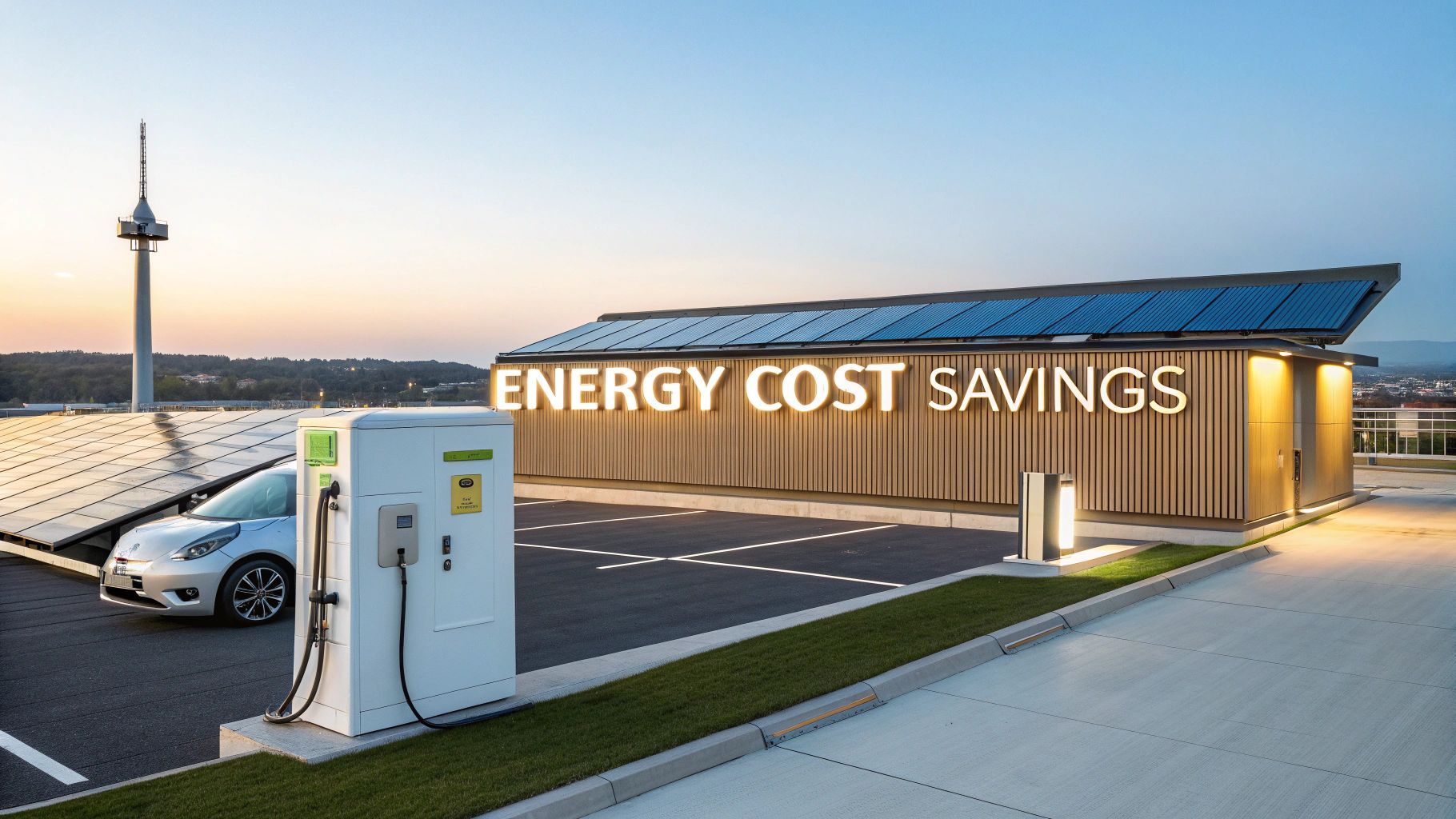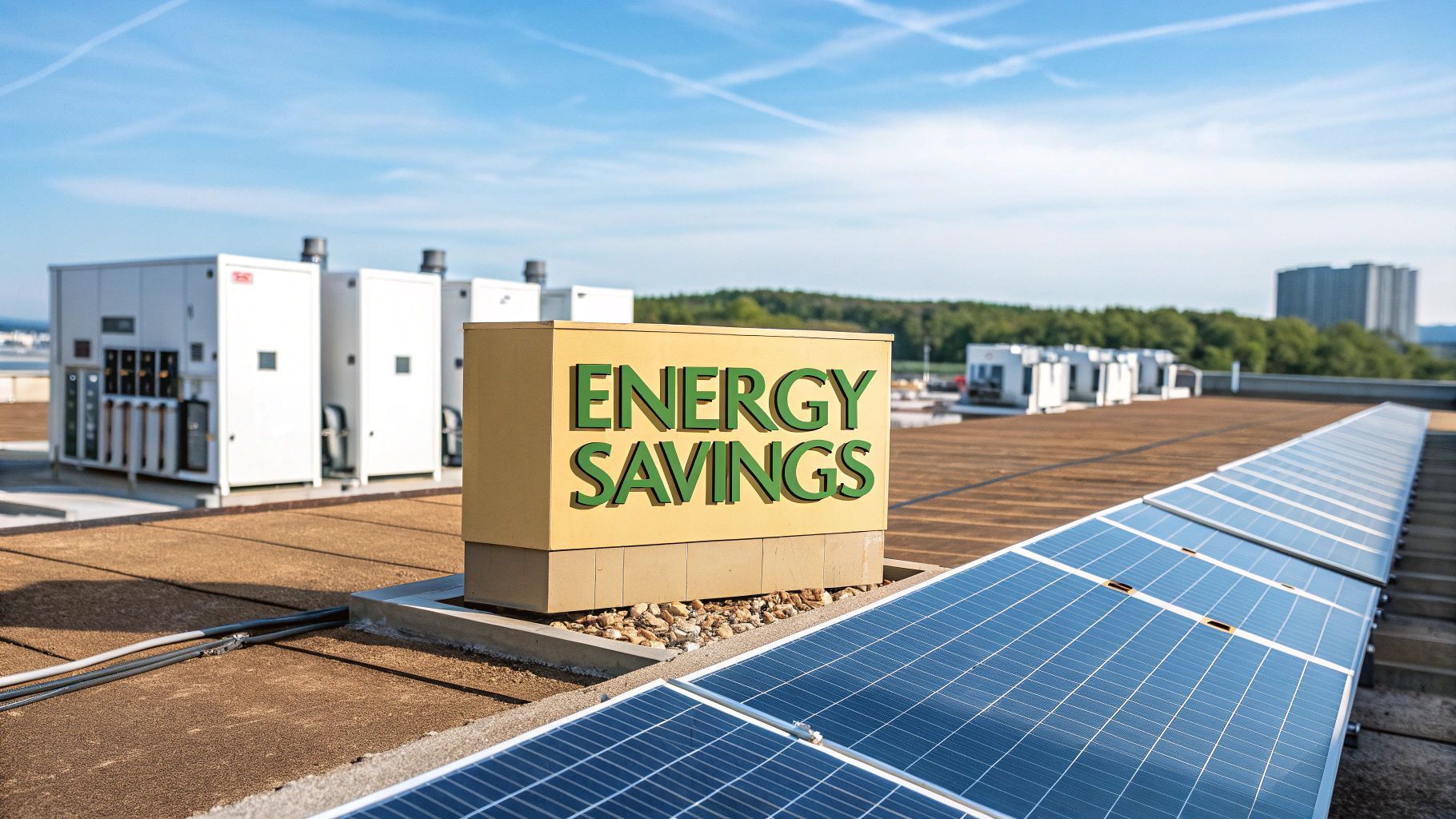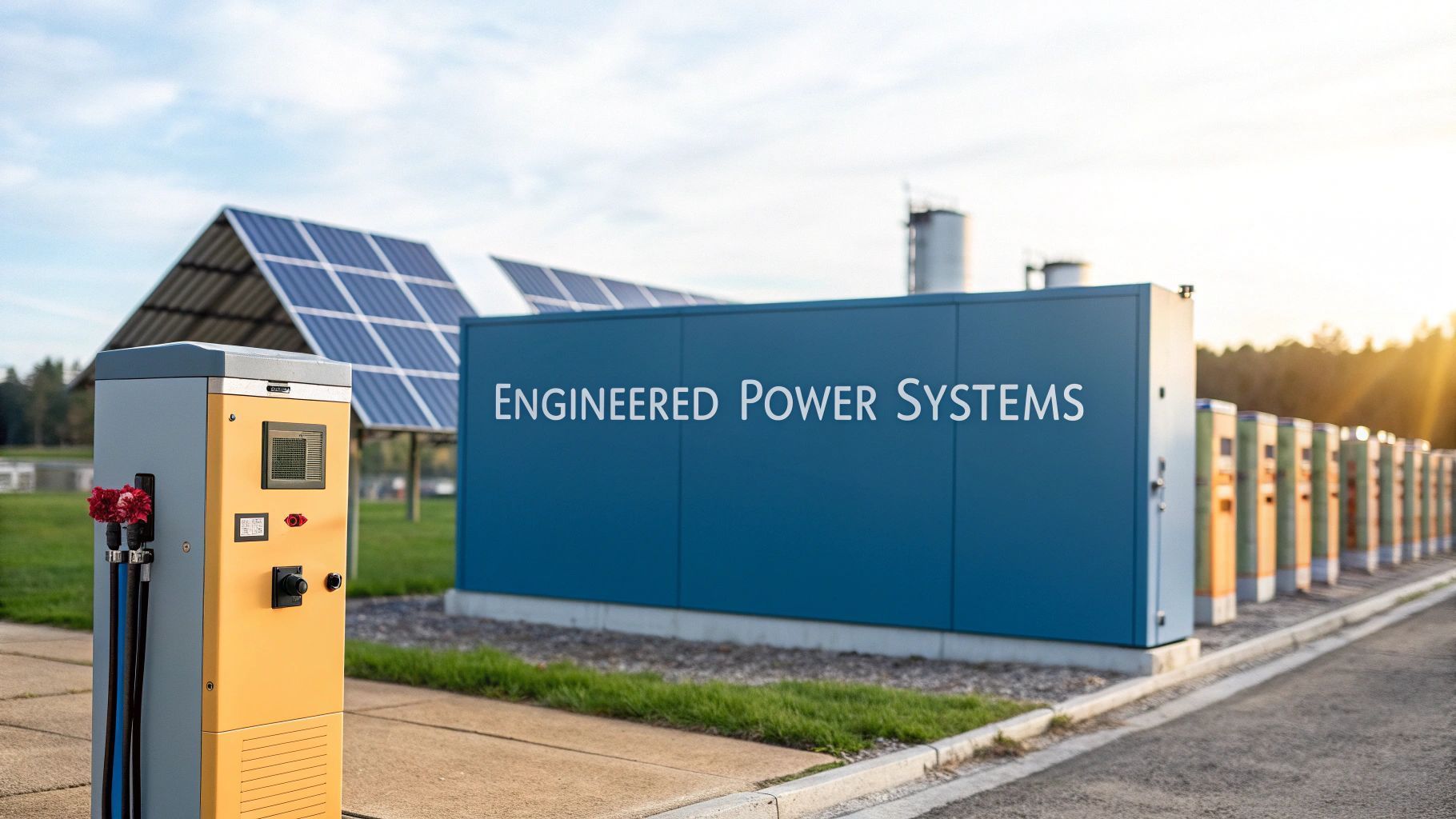Battery Pack for Car Charging: Powering the Future of EV Charging
Think of a battery pack for EV charging—often called a Battery Energy Storage System (BESS) —as a large-scale power bank designed specifically to fuel electric vehicle chargers. It acts as an energy reservoir, making rapid EV charging possible even at locations where the local electricity grid is not up to the task on its own.
The Role of Battery Packs in EV Charging Infrastructure
Imagine trying to fill a fire engine with a garden hose. The flow is simply too slow and impractical. This is the exact hurdle many UK sites hit when they want to install high-power, rapid EV chargers. The local infrastructure often cannot deliver the massive surge of electricity needed for fast charging.
A battery pack for car charging brilliantly solves this problem. It acts as a powerful energy buffer, separating the charger's huge demand from the grid's limited supply.
How Battery Storage Enables Rapid EV Charging
It is a simple but incredibly effective system. The BESS slowly trickles charge from the grid over several hours, much like that garden hose gradually filling a large water tank. This usually happens during off-peak times when electricity is cheaper and there is less strain on the national grid. The energy is then stored, ready and waiting.
When an EV driver plugs in, the BESS unleashes a powerful, instant torrent of electricity. This delivers the high-power charge they expect, far more than the grid connection could ever provide directly. This is a game-changer for:
- Rapid EV Charging: Delivering the 50kW to 350kW power levels needed to get an EV back on the road in minutes, not hours.
- Mobile EV Charging: Powering chargers mounted on vehicles for roadside assistance or providing temporary charging at events.
- EV Charging from Constrained Grid Connections: Allowing charging hubs to operate without getting bogged down in costly and time-consuming grid upgrades.
In essence, a battery pack acts as the crucial middleman. It intelligently manages the flow of energy, soaking it up when it is available and delivering it precisely when it is needed for a perfect charging experience.
Combined On-Site Renewables and Distributed Energy
But these systems are not just limited to grid power. A battery pack for car charging can be paired with on-site renewables, like solar panels on a car park canopy. The battery stores clean energy generated during sunny days and deploys it to charge vehicles at any time, even overnight. This creates a greener, more self-sufficient charging ecosystem.
By storing and deploying energy locally, BESS becomes a cornerstone of a distributed energy network. These systems help stabilise the local power supply, support the wider grid during peak demand and pave the way for a more resilient and flexible energy future across the UK.
How Battery-Assisted Charging Solves Grid Constraints
The UK’s ambition for an all-electric future is bumping up against a major roadblock: our national grid. There are countless perfect spots for rapid EV charging hubs, from rural service stations to bustling city retail parks, that do not have the electrical muscle to support high-power chargers. The traditional fix? Eye-wateringly expensive and slow grid reinforcement projects.
This is where a battery pack for car charging comes in as the great equaliser. These systems, known in the industry as Battery Energy Storage Systems (BESS), create a buffer between the sudden, massive power demand of a rapid charger and the steady but limited supply from the local grid connection. It is a clever workaround that sidesteps the need for a massive infrastructure overhaul.
Instead of trying to pull a huge surge of power directly from the grid all at once, a battery-assisted system plays the long game. It patiently ‘trickle charges’ its internal battery from a weak grid connection, slowly building up a huge reserve of energy over many hours.
Turning Constrained Grid Connections Into Power Hubs
Think of it like a water butt collecting rainwater from a thin drainpipe. The pipe might only deliver a slow, steady trickle but over time, that butt fills up with a massive volume of water. When you suddenly need to fill a big bucket, you can open the tap and get a powerful gush—far more than the small drainpipe could ever provide on its own.
A BESS does exactly the same thing but with electricity. It quietly stores up energy from a low-power connection and then unleashes it in a powerful burst of rapid EV charging the moment a driver plugs in. This is the key to unlocking sites previously written off as unworkable.
By acting as an energy buffer, a BESS allows a site with just a 100kW grid connection to deliver charging speeds of 300kW or more. This helps businesses avoid the multi-million-pound costs and multi-year delays that come with applying for a new, more powerful grid connection.
This technology transforms locations that were once non-starters into profitable, high-power charging destinations. It gives businesses the power to enter the EV charging market without being held hostage by the limitations of their existing electrical setup, which is absolutely vital for building out a truly comprehensive and accessible charging network.
Real-World Scenarios and Mobile EV Charging
The practical uses for this technology are already making a huge impact. A battery pack for car charging opens the door to a whole range of mobile EV charging services and fixed installations that simply were not possible before.
Just look at these real-world examples:
- Remote Tourist Destinations: A hotel in the Scottish Highlands with a notoriously weak rural grid connection can install a BESS and offer the rapid charging that attracts affluent EV-driving tourists, who might otherwise have skipped the location due to range anxiety.
- Urban Retail Parks: A shopping centre can add a bank of rapid chargers without disrupting its existing power supply or getting hit with huge utility bills for grid upgrades. This helps increase customer dwell time and, ultimately, their spending.
- Logistics Depots: A delivery company can install a battery system to manage its overnight fleet charging. It can draw cheap, off-peak electricity to fill the BESS, then use that stored energy to rapidly charge its vans first thing in the morning without putting a strain on the local network.
Beyond fixed sites, this technology is the engine behind mobile EV charging. A battery pack mounted on a van can provide emergency roadside assistance to stranded EV drivers or be deployed at festivals and events to offer temporary charging where no permanent infrastructure exists. This kind of flexibility is essential as we move towards a more distributed energy future.
A Look Inside EV Charging and Batteries Technology
To really get your head around how a battery pack for car charging changes the game for energy delivery, we need to look under the bonnet at the technology powering it. At the core of most modern Battery Energy Storage Systems (BESS) are Lithium-Ion cells, but they are not all the same. The specific chemistry inside these batteries dictates everything from their safety profile to how long they will last.
The two players dominating this space are Lithium Iron Phosphate (LFP) and Nickel Manganese Cobalt (NMC) . Each brings a unique set of pros and cons to the table, making the choice between them a crucial decision that hinges on what you need the charger to do. It is a classic balancing act between power, safety, longevity and cost.
If you fancy a deeper technical dive, you can explore our comparative overview of Lithium-Ion chemistries.
LFP vs. NMC: The Two Main Contenders
LFP batteries have earned a stellar reputation for being exceptionally safe and built to last. They are more thermally stable, which is a technical way of saying they are far less likely to overheat—a massive plus for high-power jobs like rapid EV charging . This stability also gives them an impressive cycle life, often good for thousands of charge and discharge cycles before they start to degrade.
On the other hand, NMC batteries are all about high energy density. This means they can pack more energy into a smaller, lighter package. That makes them perfect for mobile EV charging units where every bit of space and weight counts. However, this power comes with a trade-off: they are not as thermally stable and have a shorter operational lifespan compared to their LFP cousins.
To help you visualise what matters in a typical battery unit, the infographic below gives a closer look.
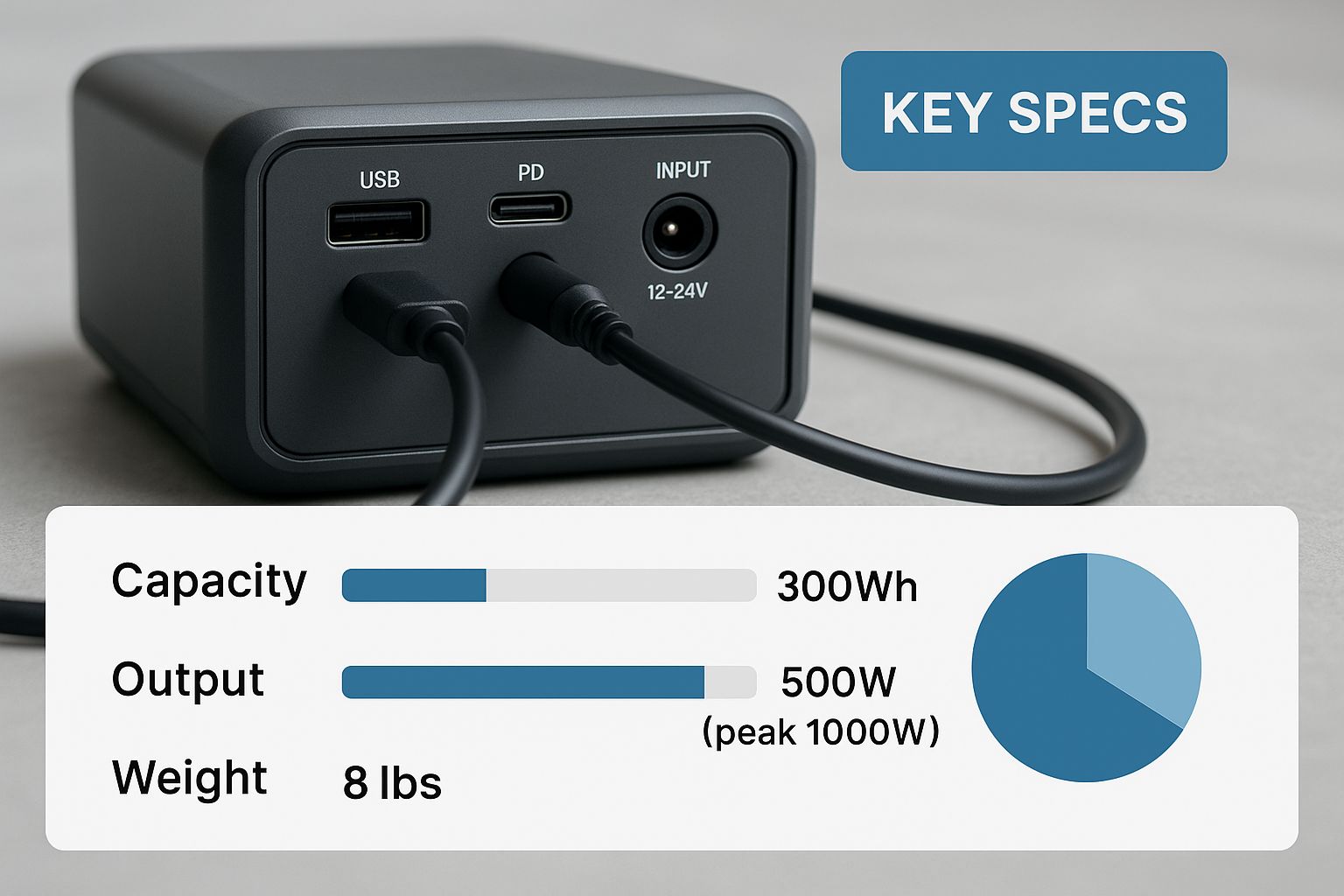
It really highlights how crucial metrics like capacity, power output and physical size are for anyone designing these systems.
The choice between LFP and NMC nearly always comes down to the job at hand. For a fixed, high-use charging hub at a service station, the safety and longevity of LFP make it the clear winner. But for a compact, van-mounted mobile charger, the lighter, more energy-dense NMC chemistry is often the smarter pick.
A key takeaway is that LFP's chemical stability often translates to a lower total cost of ownership over the system's life, even if its initial cost is comparable to NMC. Its durability makes it a workhorse for stationary distributed energy assets.
System Shapes and Sizes: From Mobile to Grid-Scale Batteries
The physical form of a battery pack for car charging is just as varied as its internal chemistry. Designs are tailored to fit the environment and the power required, ranging from small mobile units to colossal grid-scale batteries.
- Mobile EV Charging Units: Often built into vans or trailers, these house a relatively small but potent NMC battery pack. They are all about flexibility, designed to provide roadside assistance or temporary power at events.
- Cabinet-Sized Systems: For commercial sites like retail parks or offices, BESS often arrives in cabinets about the size of a large fridge. These LFP-based systems can support a handful of rapid chargers by buffering a weak grid connection.
- Containerised Grid-Scale Batteries: The largest systems are housed in shipping containers. You will find these at dedicated charging forecourts or paired with renewables like solar farms, providing immense power to support dozens of ultra-rapid chargers at once.
To make the differences even clearer, the table below compares the key attributes of the main battery chemistries used in these systems.
Comparing Common BESS Battery Chemistries for EV Charging
| Metric | Lithium Iron Phosphate (LFP) | Nickel Manganese Cobalt (NMC) |
|---|---|---|
| Safety | Excellent thermal stability, lower fire risk. | Good, but requires more complex thermal management systems. |
| Lifespan (Cycle Life) | Very high, typically 3,000 to 10,000 cycles . | Moderate, typically 1,000 to 3,000 cycles . |
| Energy Density | Lower, meaning it is heavier for the same capacity. | Higher, offering more energy in a lighter package. |
| Cost | Generally lower cost per kWh over its lifetime. | Higher material costs, particularly due to cobalt. |
| Best Use Case | Stationary rapid charging hubs, grid-scale batteries. | Mobile EV charging, applications where weight is critical. |
Ultimately, the technology inside these systems is chosen to match the application perfectly. Whether it is providing a quick boost on the roadside or powering a national charging network, getting the battery chemistry and form factor right is fundamental to success.
Pairing On-Site Renewables for Greener EV Charging
A battery pack for car charging does far more than just get around grid limits; it is the missing link for truly green, sustainable transport. By combining battery storage with on-site renewable energy, businesses can build a powerful, self-sufficient charging ecosystem. This pairing turns a simple charging point into a smart, decentralised energy asset.
The most common and effective setup pairs a Battery Energy Storage System (BESS) with solar panels. Picture solar canopies over your car park or panels covering a large commercial rooftop. All day long, these panels capture clean, free energy from the sun.
Without a battery, that solar power has to be used the moment it is generated or sent back to the grid, often for a pittance. A BESS completely changes the game. It acts like an energy reservoir, capturing and storing every kilowatt of solar power produced during daylight hours.
This stored solar energy can then be used whenever it is most valuable. It could power rapid EV charging long after the sun has set, supply electricity to your main building during expensive peak tariff periods or even provide a reliable backup during a grid outage. This strategy dramatically cuts your reliance on grid electricity, which can still be carbon-intensive depending on its source.
Building a Self-Sufficient Distributed Energy Hub
Integrating on-site renewables with a battery pack for car charging creates a virtuous cycle of clean energy. The system is smart enough to prioritise using the stored solar power first, only drawing from the grid when absolutely necessary. This approach delivers big returns, both financially and environmentally.
It also offers a powerful hedge against volatile energy prices. When you can generate and store your own electricity, your business is far less exposed to unpredictable market swings. The cost of charging becomes stable and predictable, based on your initial investment rather than the whims of the energy market. To see how this synergy works in detail, you can learn more about integrating renewable energy with advanced storage solutions .
By generating and storing your own clean electricity, you create a powerful buffer against energy price volatility. This moves your charging operation from being a simple energy consumer to an active energy manager, giving you greater control over your operational costs.
This kind of localised energy generation and storage is the foundation of future smart grids. Instead of depending on a massive power station hundreds of miles away, energy is produced and used right where it is needed—which is far more efficient and resilient. These distributed energy networks are the key to building a more robust national infrastructure.
The Financial and Environmental Case
The benefits of combining a BESS with renewables are compelling, creating a clear business case for investment. Of course, to store energy from solar, you first need to generate it. A professional solar installation is the first step in unlocking this potential.
Here are the key benefits of this integrated approach:
- Reduced Carbon Footprint: Powering EVs with on-site solar energy significantly lowers the overall carbon emissions of your operations, providing a powerful green credential for your brand.
- Lower Energy Bills: Maximising the use of your own free solar energy directly reduces the amount of expensive electricity you need to buy from the grid.
- New Revenue Streams: During times of high grid demand, stored energy can potentially be sold back to the grid at a profit, turning your charging hub into a revenue-generating asset.
- Enhanced Energy Security: An on-site BESS provides a reliable source of backup power, ensuring your business and its EV chargers can stay operational even during a local power cut.
Ultimately, pairing a battery pack for car charging with on-site renewables is not just about making EV charging possible; it is about making it smarter, cleaner and more financially sound. It is a forward-thinking investment in a truly sustainable energy future.
Practical Applications for Businesses and Fleets
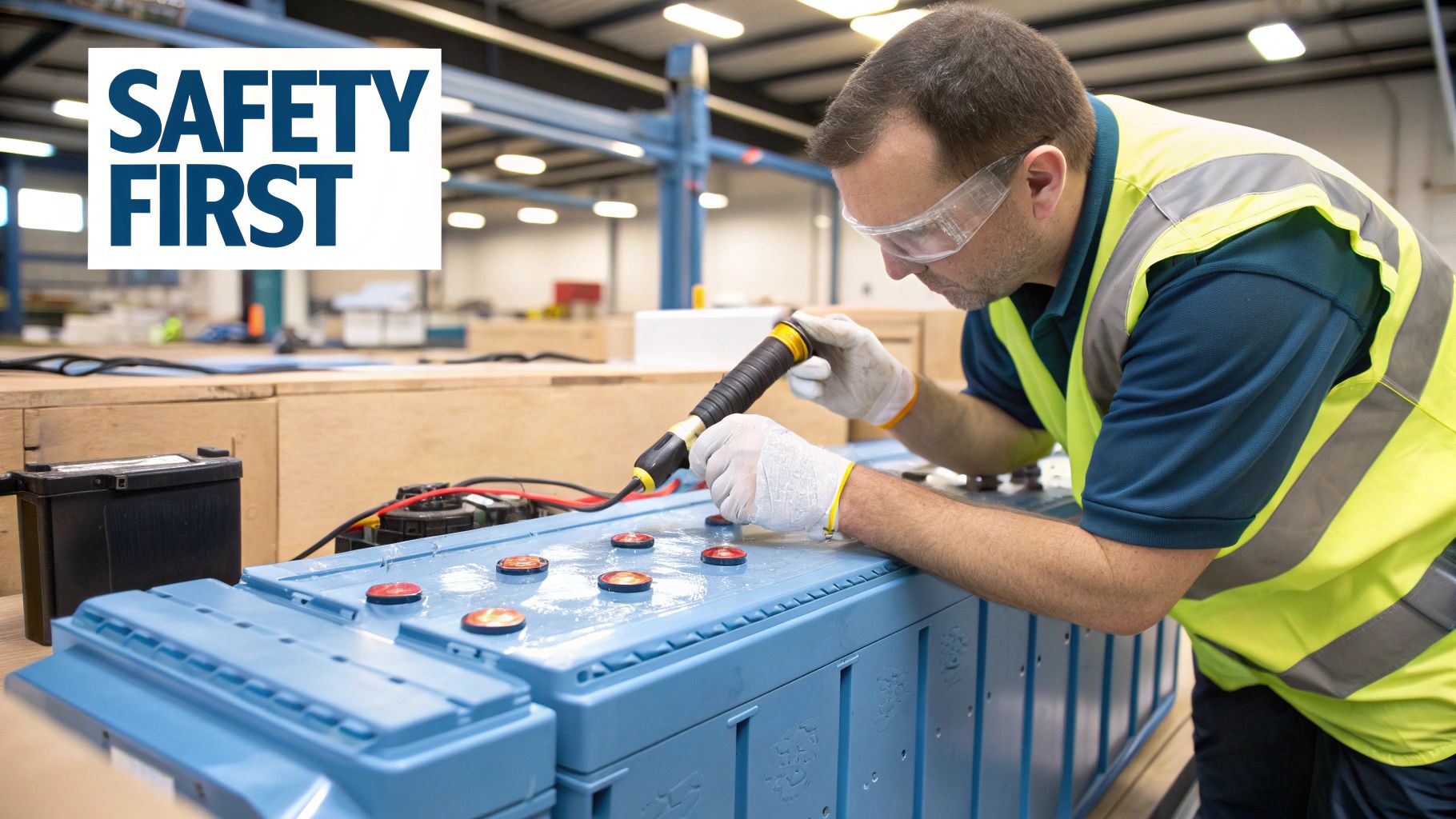
This is where the theory hits the road. Across the UK, smart organisations are already using a battery pack for car charging to gain a real commercial edge. These are not just fancy bits of kit; they are solving expensive, real-world problems, creating new revenue and making operations resilient against unpredictable energy costs.
By storing energy when it is cheap and plentiful, a business can transform a site with a constrained grid connection into a high-powered charging hub. It is about turning a liability into an asset, and the return on investment comes from both money saved and new opportunities seized. If you are weighing up your options, it helps to see what is out there, so be sure to explore top electric vehicle charging solutions for your business to get the full picture.
Overcoming Constrained Grid Connections for Fleet Charging
Let us imagine a logistics company with a growing fleet of electric vans. Their depot's grid connection is feeble—nowhere near powerful enough to charge a dozen vehicles overnight. The old-school solution? Apply for a grid upgrade. That is a process that can drag on for years and easily cost hundreds of thousands of pounds.
Instead, they install a Battery Energy Storage System (BESS). All day and all night, the BESS quietly sips power from the weak grid connection, building up a massive reserve of energy. It is timed perfectly to draw power during the cheapest off-peak hours, usually between midnight and 5 am .
When the vans roll back into the depot, they all get plugged in. The BESS then unleashes its stored energy, delivering the high-power surge needed to get the entire fleet charged and ready for the morning shift.
The benefits here are massive:
- Avoided Grid Upgrade Costs: The company completely sidesteps the huge expense and frustrating delays of a grid reinforcement project.
- Reduced Energy Bills: By buying its energy when it is cheapest, the firm slashes its operational running costs.
- Operational Certainty: No more relying on the public charging network. The fleet is always ready to roll, guaranteed.
Enabling Destination Charging in Remote Areas
Here is another classic example, this time from the hospitality world. Think of a boutique hotel tucked away in a remote corner of the Lake District or the Scottish Highlands. The local grid is often weak, making it impossible to install the rapid EV charging points that attract tourists driving electric cars.
A BESS completely changes the game. The hotel can install one, maybe even pair it with a few solar panels to store clean energy. Suddenly, they can offer guests the fast, reliable charging they expect, turning a logistical nightmare into a key selling point. This one amenity can lead to more bookings, longer stays and a brand-new revenue stream from charging fees.
A battery pack for car charging empowers businesses in grid-constrained locations to offer premium services. It turns a logistical challenge into a competitive advantage, attracting a valuable and growing customer demographic.
The Rise of Mobile EV Charging Services
The sheer flexibility of a battery pack for car charging has also sparked a whole new industry: mobile EV charging . These are essentially powerful battery systems loaded into a van, creating a charger that can go anywhere.
Roadside assistance firms are now using these mobile units to rescue EV drivers who have run flat. A quick boost gets them to the nearest static charger, a far better solution than towing the vehicle.
Mobile charging is also perfect for temporary events. A festival, conference or sporting event can bring in mobile chargers to serve attendees without needing permanent infrastructure. It is a fantastic service that also opens up another way to generate revenue. These systems bring power directly to where it is needed, exactly when it is needed.
The Future of EV Charging and Batteries in the UK
Looking ahead, the role of battery-supported charging in the UK is set to expand dramatically. It is rapidly moving from a clever workaround for constrained grid connections to an essential component of our national distributed energy infrastructure. This shift is not just a possibility; it is being driven by powerful market trends and ambitious government targets.
The government’s Zero Emission Vehicle (ZEV) mandate puts firm deadlines on the transition away from fossil fuels. This pressure intensifies the need for a robust and widely available rapid charging network—a challenge that a battery pack for car charging is perfectly positioned to solve, especially in grid-constrained areas.
From Grid Support to Grid Stabilisation with Grid-Scale Batteries
In the near future, these distributed energy assets will do far more than just charge cars. They will become active participants in balancing the National Grid.
By storing energy during times of low demand or high renewable generation from combined on-site renewables and releasing it during peak hours, they will offer vital grid stabilisation services like demand response. This capability is crucial as the UK integrates more intermittent renewables like wind and solar. These intelligent battery systems will help create a more flexible and resilient energy network for Great Britain. You can learn more about how our battery storage systems are powering the UK's EV revolution to see this technology in action.
Alleviating Charging Anxiety and Fuelling Adoption
One of the main hurdles to widespread EV adoption remains ‘charging anxiety’—the fear of not finding a reliable charger when you need one. Battery-backed charging hubs help to close the gap between fleet and private EV uptake by making rapid charging a dependable reality everywhere, from remote rural locations to dense urban centres.
The core message is that a battery pack for car charging is not merely a fix for a weak grid connection. It is an intelligent, foundational element of a modern, flexible and resilient energy system designed to support the UK's electric future.
This progress is already being recognised on an international scale. The UK’s climb to fifth place in a recent eReadiness survey reflects both the strides made and the challenges that remain in creating a seamless transition to battery-powered transport. As we uncover more insights about EV adoption in the UK, it is clear that overcoming these infrastructure hurdles is paramount.
Ultimately, as distributed energy resources become more integrated, they will not just power our vehicles. They will actively support the stability and efficiency of the entire national grid.
Got Questions? We've Got Answers.
Here are some clear, straightforward answers to the questions we hear most often about battery-supported EV charging. This should help you get a better sense of the costs, installation and whether it is the right fit for your business.
How Much Does A Battery-Supported EV Charging System Cost?
There is no single price tag, as costs vary widely depending on the battery's capacity (kWh) and its power output (kW). For a small business, a complete system could range from tens of thousands to over a hundred thousand pounds.
The final figure really depends on how many chargers you need, how fast you want them to be, the type of battery chemistry you choose and the specifics of your site installation. While it is a significant investment, you have to weigh it against the potentially crippling costs and long delays of a grid upgrade—not to mention the energy savings you will pocket from charging the batteries when electricity is cheap.
Can I Add A Battery Pack To My Existing EV Chargers?
Yes, you often can. Retrofitting a Battery Energy Storage System (BESS) to an existing charger setup is a popular move for sites that have outgrown their grid connection. It is a smart way to boost your charging power without ripping everything out and starting again.
It does require specialist engineering to make sure the new and old components communicate and operate safely together. But when done right, it is a brilliant way to scale up your charging capabilities as demand grows.
A battery pack can breathe new life into an existing setup. It allows businesses to expand their charging capacity in response to growing demand, protecting their initial investment while future-proofing their operations.
Is A Battery Pack For Car Charging Suitable For A Small Business?
Absolutely. In fact, it can be a game-changer. For small businesses like cafes, local shops or guest houses with a constrained grid connection, a smaller-scale BESS is the perfect solution. It lets you offer the kind of rapid EV charging that attracts and keeps customers, all without the eye-watering cost of a new grid connection.
Even a modest system can comfortably power one or two fast chargers. This simple addition can dramatically increase how long customers stay and how much they spend, making a battery pack for car charging a savvy investment in your future growth.
Ready to overcome your grid limitations and unlock the potential of rapid EV charging? Contact ZPN Energy today to discover how our British-made battery storage and charging solutions can power your business forward. Explore our advanced energy systems.


